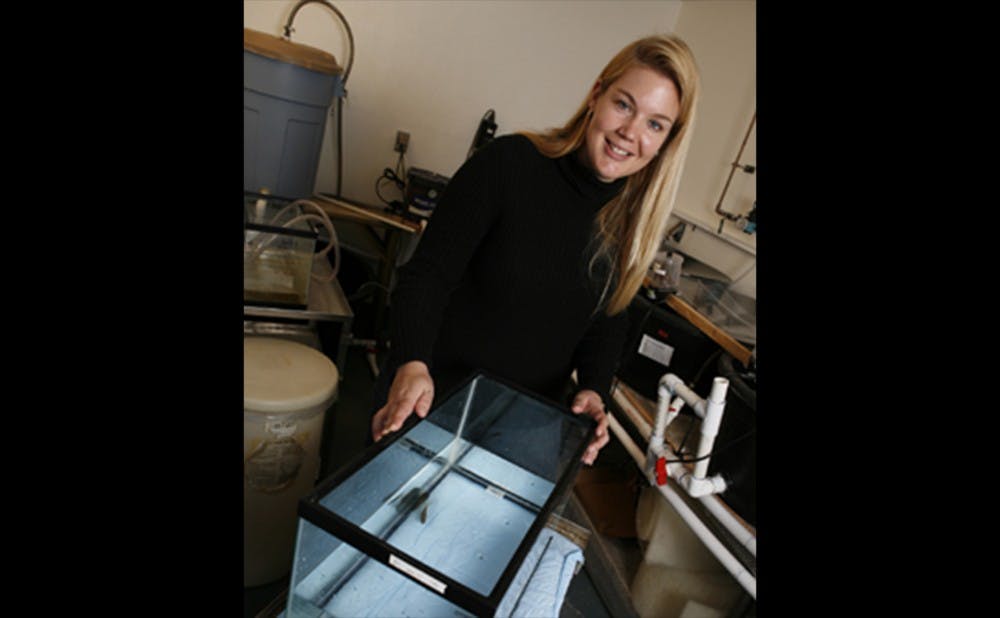Women who are trying to get pregnant through in-vitro fertilization may want to consider staying away from nail polish, according to a recently published study by researchers from Duke, Harvard University and the University of Michigan.
The researchers—including Heather Stapleton, Dan and Bunny Gabel associate professor of environmental ethics and sustainable environmental management, and Craig Butt, a former postdoctoral student in Stapleton’s lab at the Nicolas School of the Environment—found that organophosphate flame retardants (PFRs) in many common items decrease the chances of successful in-vitro fertilization.
Stapleton wrote in an email that the groups at Harvard and Michigan had been interested in environmental factors and IVF outcomes for years, but this project came together when they reached out to the Stapleton lab, which has expertise in flame retardants.
"The samples were collected from couples undergoing IVF treatments at a facility in Massachusetts, and archived at Harvard University," Stapleton wrote in an email. "To facilitate this project, urine and serum samples were shipped to my laboratory at Duke University, and we analyzed the urine for organophosphate flame retardant/plasticizer metabolites."
Courtney Carignan, who conducted the study as a postdoctoral fellow at the Harvard T.H. Chan School of Public Health, wrote in an email that PFRs were actually supposed to be safer than flame retardants used in the past.
“The flame retardant PentaBDE, used in polyurethane foam, was phased out more than a decade ago after it was linked with negative health effects in animal and epidemiological studies,” Carignan wrote. “PFRs were introduced as a safer alternative, but they have also been found in animal studies to disrupt thyroid and sex hormones—which are important for fertility and fetal development.”
Carignan noted that like the PentaBDE flame retardant, PFRs can migrate out of furniture and other products into the air of indoor environments.
PFRs are often found in consumer products that contain polyurethane foam, including upholstered furniture, mattress pads, nap mats and car seats, Carignan explained. One PFR in particular—triphenyl phosphate—is used as a replacement for phthalates in nail polish, she added.
With the prevalence of PFRs in everyday objects, Carignan offered a surprisingly simple solution for couples worried about the effects of the flame retardant.
“Couples wishing to reduce their exposure to these chemicals may benefit from avoiding nail polish and washing their hands several times throughout the day, particularly before eating, as previous studies have shown that people who wash their hands more frequently have lower levels of these chemicals in their bodies,” Carignan wrote.
Carignan warned that couples looking to purchase products without flame retardants should confirm that a product is “free of flame retardant chemicals” and not “free of harmful flame retardants.” Products with the latter, she wrote, may still contain PFRs.
One product that is still safe to use, though? Yoga mats, Carignan wrote.
Despite several headlines suggesting that yoga mats cause infertility, Carignan emphasized that certain media outlets had confused yoga mats with gym mats. Yoga mats do not have PFRs, but gym mats and pit cubes do.
“There is no evidence that flame retardants are used in yoga mats; this reporting appears to be a misinterpretation of the term ‘gym mat,’” Carignan wrote.
Even though couples can make efforts to avoid certain products, Stapleton noted that it is largely impossible to avoid exposure to PFRs altogether.
"We’re exposed to them on a daily basis in our homes, cars and work/class environments. And even if someone did want to look for safer alternatives, it’s actually impossible to know where your exposure is coming from," Stapleton wrote. "PFRs are used in insulation, furniture, textiles and electronics, and labels are not provided on these products to indicate whether PFRs are present or not."
Despite some limitations, Carignan wrote that the study’s findings could apply to a larger population beyond women with fertility issues.
Future studies may investigate the relationship of PFR exposure and fertility in the general population, she wrote. They could explore how the PFR affects the contribution of the male partner, since men and women are equally impacted by infertility.
“While results are directly generalizable to the infertile population, they may also apply to all women in general—presuming that their bodies have the same biological response to these chemicals as women undergoing [in-vitro fertilization],” Carignan wrote.
Anyone interested in learning what flame retardants their furniture contains can send a sample to the Pratt School Engineering for free testing.
Get The Chronicle straight to your inbox
Signup for our weekly newsletter. Cancel at any time.

